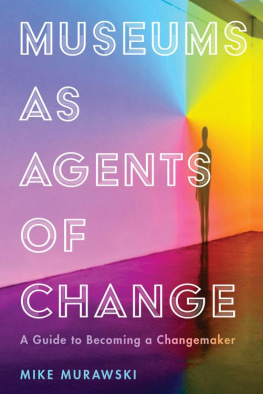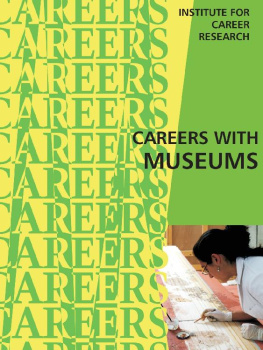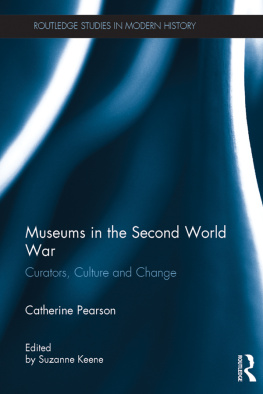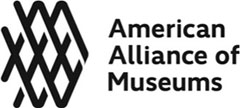Museums as Agents of Change
AMERICAN ALLIANCE OF MUSEUMS
The American Alliance of Museums (AAM) has been bringing museums together since 1906, helping to develop standards and best practices, gathering and sharing knowledge, and providing advocacy on issues of concern to the entire museum community. Representing more than 35,000 individual museum professionals and volunteers, institutions, and corporate partners serving the museum field, the Alliance stands for the broad scope of the museum community.
The American Alliance of Museums mission is to champion museums and nurture excellence in partnership with its members and allies.
Books published by AAM further the Alliances mission to make standards and best practices for the broad museum community widely available.
Published by Rowman & Littlefield
An imprint of The Rowman & Littlefield Publishing Group, Inc.
4501 Forbes Boulevard, Suite 200, Lanham, Maryland 20706
www.rowman.com
6 Tinworth Street, London SE11 5AL, United Kingdom
Copyright 2021 by American Alliance of Museums
All rights reserved. No part of this book may be reproduced in any form or by any electronic or mechanical means, including information storage and retrieval systems, without written permission from the publisher, except by a reviewer who may quote passages in a review.
British Library Cataloguing in Publication Information Available
Library of Congress Cataloging-in-Publication Data
Names: Murawski, Michael, 1977 author. | American Alliance of Museums, issuing body.
Title: Museums as agents of change : a guide to becoming a changemaker / Michael Murawski.
Description: Lanham : Rowman & Littlefield, [2021] | Includes bibliographical references and index.
Identifiers: LCCN 2020054142 (print) | LCCN 2020054143 (ebook) | ISBN 9781538108949 (cloth) | ISBN 9781538108956 (paperback) | ISBN 9781538108963 (epub)
Subjects: LCSH: Museums and community. | Social action.
Classification: LCC AM7 .M77 2021 (print) | LCC AM7 (ebook) | DDC 069dc23
LC record available at https://lccn.loc.gov/2020054142
LC ebook record available at https://lccn.loc.gov/2020054143
 The paper used in this publication meets the minimum requirements of American National Standard for Information SciencesPermanence of Paper for Printed Library Materials, ANSI/NISO Z39.48-1992.
The paper used in this publication meets the minimum requirements of American National Standard for Information SciencesPermanence of Paper for Printed Library Materials, ANSI/NISO Z39.48-1992.
To my son Holden.
May we always be changing, learning, and working toward a better, more loving future.
Contents
Guide
F or me, writing a book like this has been a journey that could not have been possible without so many other people. As I write these pages of gratitude, I am thinking of the words of educator and organizer Mariame Kaba: Everything worthwhile is done with other people. Nothing could be more true. Rather than isolated individuals striving to achieve our own greatness in this world, we are all parts of intricate networks of human relationships. Our ideas, inspirations, and creativity flow out from this river of inseparable interconnection, and we all owe immense gratitude to those around usnear and farthroughout our lives. While the list of people who have had a role in shaping my ideas, beliefs, and values is far longer than could ever fit in these pages, I want to recognize many of those whose guidance and patience helped make this book become a thing you are now holding in your hands.
Across the past twenty years, I have had the privilege of working with some of the most amazing and dedicated educators, artists, museum professionals, community organizers, and leaders. Among the hundreds of individuals that Im proud to have worked alongside and with over the years, I want to celebrate a few that continue to stand out to me right now as I put the finishing touches on this book project.
I want to thank Cheryl Benjamin, who always made me a better educator and a better human being; Monica Montgomery, who has always taught me to be tenacious and to stand up for what I believe in; Rika Burnham and Elliott Kai-Kee, who guided my first great museum experience one summer many years ago at the Art Institute of Chicago and have always been such strong mentors; La Tanya S. Autry, who has challenged and helped shape so many of my ideas about the transformation needed in museums right now; Nina Simon, who has always helped me become a stronger thinker and a more rebellious changemaker; Stephanie Parrish, who got me into this museum thing to begin with; and Teressa Raiford, who showed me that museums can be so much more than they are. I am grateful for all my teachers, guides, and mentors over the years, and to those who continue to guide and support me.
I also want to thank all those who also agreed to be part of the conversations and dialogues that have been included in this book: Nina Simon, La Tanya S. Autry, Lori Fogarty, Lauren Ruffin, Molly Alloy, Nathanael Andreini, and Monica Montgomery. So much of what I have learned about changing museums has been in conversation with others, and it has been important to me that this book honor that process of dialogue and shared discovery.
I want to thank each and every individual who has contributed to ArtMuseumTeaching.com over the past ten years. This site began as simply a space for me to share my own passion for museum teaching, and it grew into a thriving community of educators, thinkers, and change leaders who see the potential of museums as spaces of experimentation, connection, community, equity, care, and belonging. This book would not be possible without everyone who has contributed to and supported this site over the years.
I am grateful to my editor, Charles Harmon, for his guidance, and to the entire team at Rowman & Littlefield Publishing and the American Alliance of Museums for being willing to support me and help me get my ideas out into the world.
My deep thanks go to my family. To my dad who has always been there for me, and to my mom whom I know is looking down on me with immense pride. I am walking down this path right now thanks to my parents who helped set my course.
To my wife and partner in life, Bryna. Without your patience, love, and support, I would not be writing this book. You have put up with so many conversations about museums, and youve challenged my ideas in ways that make me stronger. You have shaped who I am, what I believe in, and my passion to stand up and speak out for what is right. I am so grateful to be on this journey with you.
Finally, to my son Holden. This book is for you. Always remember to stand up and speak out, too, for what you believe in. I know you are going to be a part of making this world a better place.
Museums as Agents of Change
M useums everywhere have the potential to serve as agents of social changebringing people together, contributing to local communities, and changing peoples lives. Yet, for far too many institutions, this potential continues to go largely untapped. Many museum leaders and professionals remain ambivalent about the social responsibilities of museums and uncertain about the capacity of museums to function as agents of positive change in society. Given the ongoing pandemic and our current moment of continued political polarization, highly contested social debates, and widespread global efforts to confront oppression, now is the time to challenge the entrenched traditional notions of museums and proactively shape a new future.
I think in moments like these, its important for all of uswhether you work for a museum or notto pause and reflect on the roles that these institutions serve within our communities. Yes, museums are largely institutions that hold, preserve, and exhibit objects and collections. But they are also living institutions that serve a powerful role as active spaces for connection and coming together; for dialogue and difficult conversations; for listening and sharing; and for care, healing, and repair. Museums have the potential to tell new and diverse histories; amplify marginalized voices; celebrate unheard stories; and recognize the creativity, knowledge, expertise, and lived experience that is already thriving within their local communities. They can be spaces for acknowledging and reflecting on difference, and for bridging divides. They can be spaces for justice, growth, struggle, love, and hope. Now is the time for us to become changemakers and realize the potential of museums as transformative spaces of human connection, care, listening, and deep learning.
Next page






 The paper used in this publication meets the minimum requirements of American National Standard for Information SciencesPermanence of Paper for Printed Library Materials, ANSI/NISO Z39.48-1992.
The paper used in this publication meets the minimum requirements of American National Standard for Information SciencesPermanence of Paper for Printed Library Materials, ANSI/NISO Z39.48-1992.